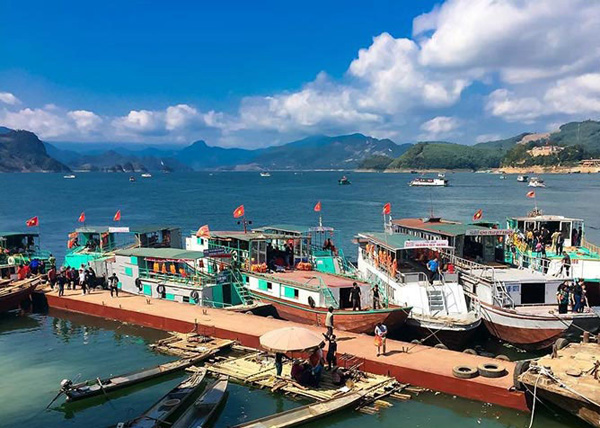



Thung Nai (Cao Phong) with many beautiful scenes, is an attractive destination for tourists to explore the area of Hoa Binh lake.
Paying attention to investing in building the infrastructure, the physical and technical facilities, contributing to the effective exploitation of the potentials and advantages of the tourism area, the province has implemented the projects of upgrading roads. Currently, in the tourism area of Hoa Binh Lake there have been over 200 means of transporting tourists, 107 accommodation establishments (14 hotels, 32 motels, 61 community motels).
In addition, the province has mechanisms and policies to support and attract investment in tourism development with the preferential corporate income tax, the import and export tax, the land rental during project implementation. So far, in the area of Hoa Binh lake there have been 16 projects invested in services, culture, licensed tourism, or granted investment certificates. The total used land is about 1,444 ha with the total capital of about 3,303.9 billion dongs from investors. Eleven projects invested in developing tourism with the total used land of about 757 ha and the total investment capital of over 3,200 billion VND have been attracted. The objectives of the projects are to meet the needs of tourism, convalescence and recreation services, combining afforestation, forest protection, preserving ethnic cultures, spiritual tourism, etc.
Besides tourism attractions such as Thac Bo temple (Cao Phong - Da Bac), Bo cave (Tan Lac), Dua island, Doi Co temple (Da Bac), Green island (Cao Phong), other community tourism points in Ke hamlet, Duc Phong hamlet (Da Bac), Ngoi hamlet (Tan Lac) ..., there are some new eco-tourism destinations and places in the tourism area of Hoa Binh lake. They are Mai Chau Hideaway, Ba Khan ecological tourism area (Mai Chau), Sunlegend - Ecolodge (Da Bac). Additionally, other attractive tourism products such as the water park with over 130 games of water motor, high-speed boat of high quality in Ngoi hamlet, Suoi Hoa commune have been attracting many tourists. The province has also opened a walking and a cycling route along the banks of Da River. A weekend resort has been built on the tourism area, and an experience program has also set up in the area of Hoa Binh lake.
At present, the tourism activities in the tourism area of Hoa Binh lake are flourishing, contributing to the economic restructure, creating jobs, increasing the budget revenue and improving the income and the material and the spiritual life for the local people. In 2019, the tourism area welcomed 550,000 turns of visitors, accounting for about 17.7% of the total number of the tourists in the province, in which, there were about 26,000 turns of the international visitors. The total revenue from tourism activities was about 160 billion VND, accounting for 7.7% of the total revenue from tourism activities of the province.
In order to accomplish the objectives and tasks of building the tourism area of Hoa Binh reservoir in 2020, which initially meets the conditions, the province has focused on synchronously implementating many solutions such as integrating the capital sources, prioritizing the arrangement from the state budget to invest in the technical infrastructure, especially the roads, boat stations connecting the tourist sites. They have also focused on promoting the investment in developing the tourism projects with 3-star or higher standards, developing the standard restaurants, the eco-tourism and resort of high quality, strongly developing the community tourism. It is necessary to have policies to support investment in exploiting the potential of developing the tourism of culture, ecology, convalescence, sports and entertainment, enhancing information, promoting images and tourism products, and effectively implementing the smart travel website to promote the tourism.